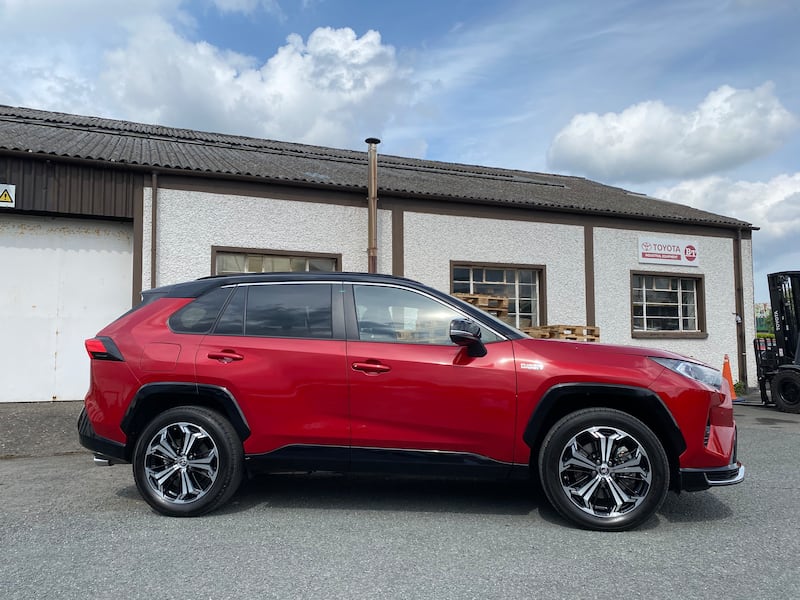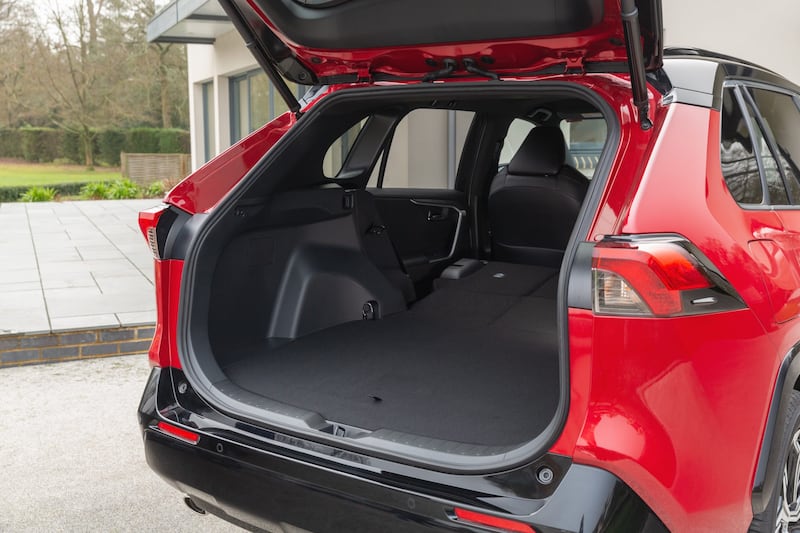It’s a slightly depressing fact that the current Toyota RAV4 is about half again the size of the original three-door version, first launched in 1994. That original RAV4 was a zippy and engaging little thing, and little is the right word – the three-door model measured just 3.7m in length, shorter than a current VW Polo.
In fact, the new Yaris Cross is almost identical in its exterior dimensions to the first-generation five-door RAV4, which should tell you all you need to know about how big the current one has become. Bigness means you need more power to shunt it about, but of course power comes with the penalty of emissions and consumption, unless you can find a clever way to square that circle.
Toyota has done just that. This is the RAV4 plug-in hybrid, and plug-in hybrid (or PHEV, plug-in hybrid electric vehicle) has become something of a dirty word in some motoring circles of late. Owners and proponents of pure-electric cars tend to either sneer at PHEVs, rage at them when they use public charging points, or damn them entirely, with the likes of environmental pressure group Transport & Environment labelling them “fake electric cars”.
That vitriol is based on the supposition that most PHEVs are bought for their taxation benefits (who wouldn’t want a chunky SUV that costs just €140 a year in motor tax?) and then never, or at best rarely, plugged in and driven in electric mode. By dragging around the dead weight of a depleted battery, you’re just making a car less efficient and burning more fuel, goes the anti-PHEV argument.
Ireland and Trump’s tariffs: From pharma to booze – how will our prices, jobs and economy be hit?
Irish Times readers pick Claire Keegan’s Small Things Like These as the best Irish book of the 21st century
Trocadero restaurant review: A timeless classic that is old-school in the best sense
Nathan Johns: How will the Lions attack against Australia?
I’m not so sure about all this. In general, I’d imagine that most people who go to the effort of buying a PHEV do so with the intention of plugging it in, even if that’s most rather than all of the time (and data coming back from PHEVs brought in for service seems to back that supposition up). Equally, even if someone is only fitfully using the electric half of their PHEV, at least that’s better than no electric running at all. What is that the well-known supermarket says about every little helping?

The RAV4 PHEV is an even better riposte to the anti-PHEV arguments. For a start, it’s a properly long-range PHEV, with a claimed 75km from a full charge of its 18.1kWh battery. While all such claims can be taken with the appropriate amount of sodium chloride, the RAV4 seems able to actually back up the claim with real performance.
We easily extracted 65km of all-electric running from a full charge, and that was with air conditioning going and a bit of dual-carriageway driving. If you’re mostly driving in town, and maybe being a bit more careful with the accelerator, then 80km doesn’t seem out of the question. You’ll need a home charging point to make the most of it, of course, which does raise the question of perhaps a fully-electric car being just as useful to you, but even so the RAV4′s electric range is genuinely impressive.
That’s a good bit more useable range than most competitor products, which tend to claim 50km of range, and actually deliver between 30-40km. But of course the real rub with PHEVs usually comes when you take it out on the open road and try driving a long distance. When you do that, you’re into the dead-weight fuel consumption spiral, and looking down the barrel of massive fuel costs and relatively high emissions for your longer hauls.
Or maybe not. During the week we had the RAV4, we needed to make a round-trip run from Belfast to Dublin and back, almost all of that journey cruising between 110km/h 120km/h on motorways. Usually, that’s enough to push most PHEVs to the wrong side of 6.5 litres per 100km.
Not the RAV4, though. In fact, on those long journeys we averaged 5.3 litres per 100km, or 53mpg for those of you without a handy calculator. That’s not just comparable with the very best diesel-engined cars for long-range economy, that’s actually better than we averaged from the plain old hybrid RAV4. Toyota is clearly including a witchcraft course for its hybrid and battery apprenticeship courses.

The rest of the RAV4′s performance is broadly impressive. I love the cabin – it’s plain and simple in its style, but enlivened by neat touches such as the grippy rubber surfaces on the major controls, which give the RAV a slight flavour of rugged off-roader. (Actually, it’s surprisingly good if you do decide to head off-road – there’s an extra electric motor powering the rear wheels and while it’s no Land Rover Defender, it’ll get you to places you might not think it would). The seats are comfy, there’s acres of space front and rear, and a decent 500-litre boot.
The only problem is that it’s not all that good to drive. It’s an excellent long-haul cruiser, but on twisty roads the extra weight of the battery, and the stiffer suspension compared with the regular hybrid model make the RAV4 PHEV feel a bit plank-like. The steering is just too slow to garner any enjoyment on twisty roads, and combines with quite a bit of body roll to make you wish you were just back on the motorway. It’s a shame, as the regular hybrid RAV4 is actually quite enjoyable to drive.
Then there’s the price tag. At €51,890 for the basic Sol version, or €53,835 for the higher-spec Sport model we’re testing here, the RAV4 PHEV isn’t staggeringly expensive, but it is actually quite a bit more costly than the impressive new Toyota bz4X electric SUV, which is just about to go on sale in Ireland. The bz4X has a range exceeding 500km, and is much more responsive and enjoyable to drive than this RAV4 PHEV. And, of course, it’s fully electric, so the T&E boys will leave you alone and stop accusing you of buying a fake electric car.
The RAV4 PHEV still makes a solid case for itself, but arguably only if you’re buying it to pound the nation’s motorways day after working day, and then using its electric power for shorter weekend hops – almost the exact opposite of most PHEVs. If that’s not you, then the better-value new bz4X is probably the better choice.















